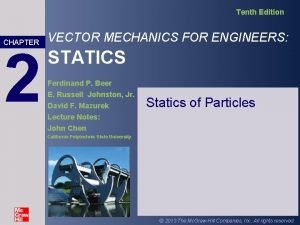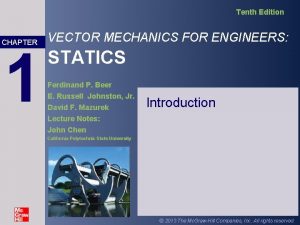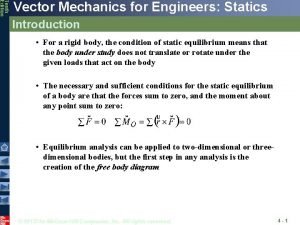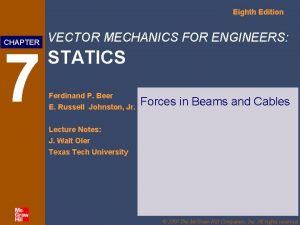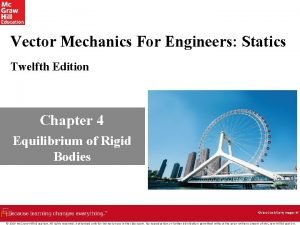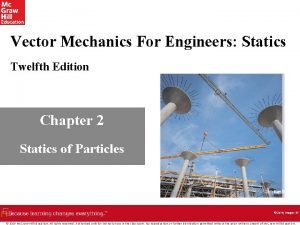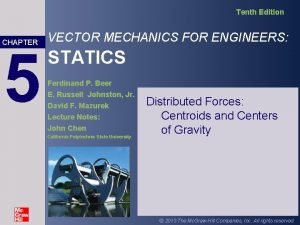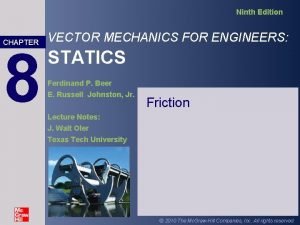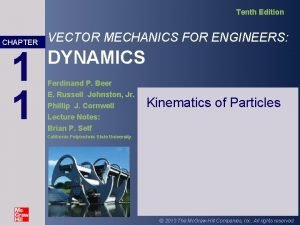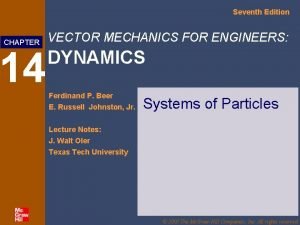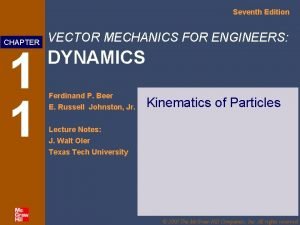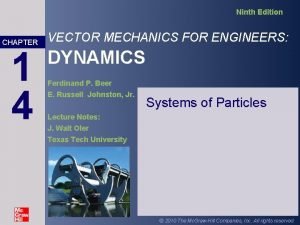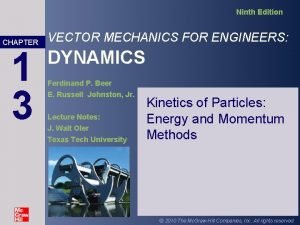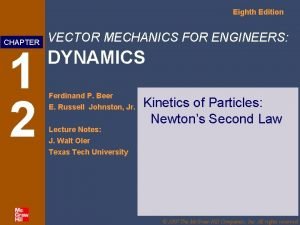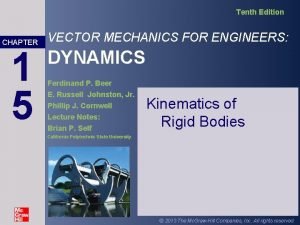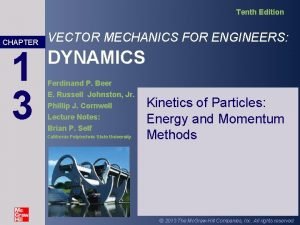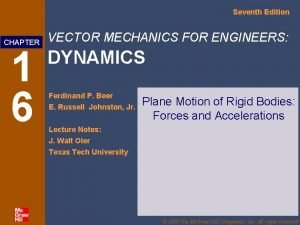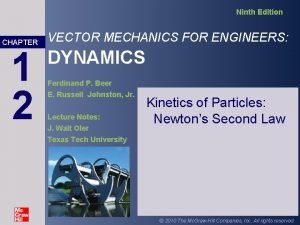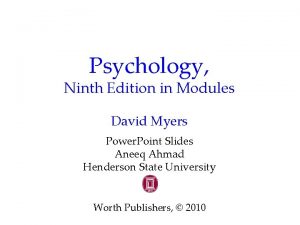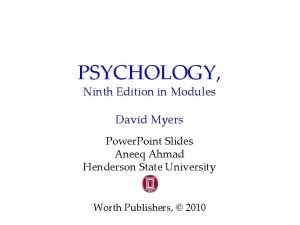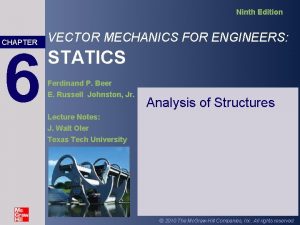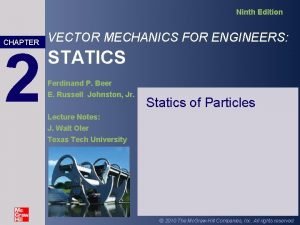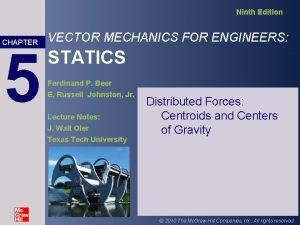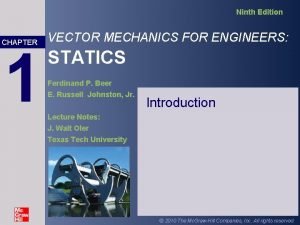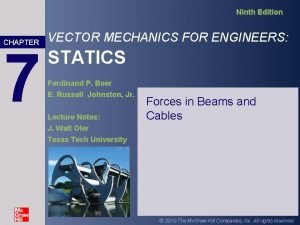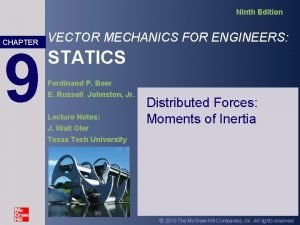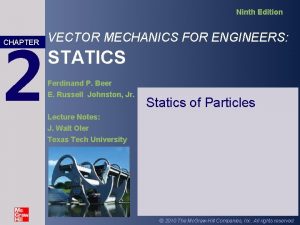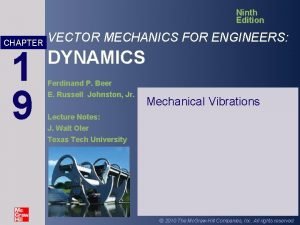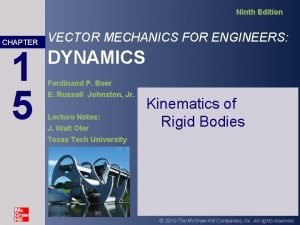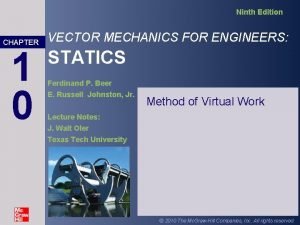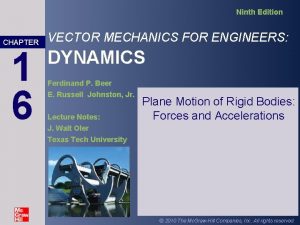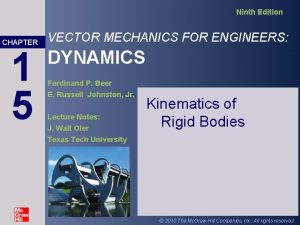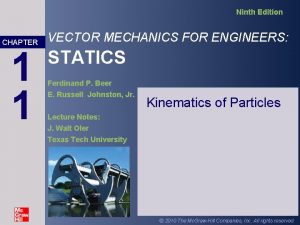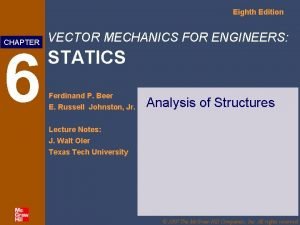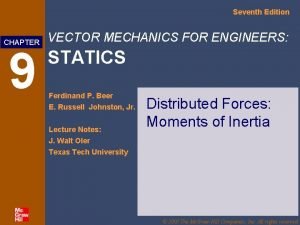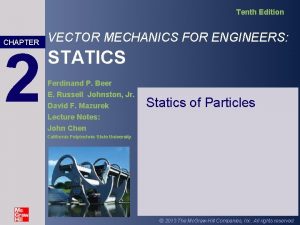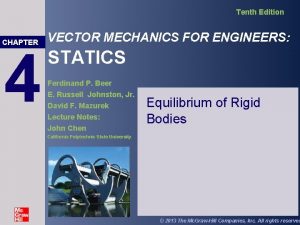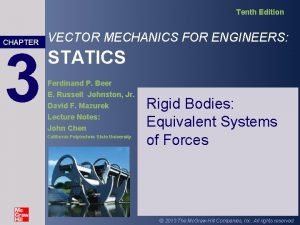Ninth Edition CHAPTER 4 VECTOR MECHANICS FOR ENGINEERS

























- Slides: 25

Ninth Edition CHAPTER 4 VECTOR MECHANICS FOR ENGINEERS: STATICS Ferdinand P. Beer E. Russell Johnston, Jr. Lecture Notes: J. Walt Oler Texas Tech University Equilibrium of Rigid Bodies © 2010 The Mc. Graw-Hill Companies, Inc. All rights reserved

Ninth Edition Vector Mechanics for Engineers: Statics Contents Introduction Free-Body Diagram Reactions at Supports and Connections for a Two. Dimensional Structure Equilibrium of a Rigid Body in Three Dimensions Reactions at Supports and Connections for a Three-Dimensional Structure Sample Problem 4. 8 Equilibrium of a Rigid Body in Two Dimensions Statically Indeterminate Reactions Sample Problem 4. 1 Sample Problem 4. 3 Sample Problem 4. 4 Equilibrium of a Two-Force Body Equilibrium of a Three-Force Body Sample Problem 4. 6 © 2010 The Mc. Graw-Hill Companies, Inc. All rights reserved. 4 -2

Ninth Edition Vector Mechanics for Engineers: Statics Introduction • For a rigid body in static equilibrium, the external forces and moments are balanced and will impart no translational or rotational motion to the body. • The necessary and sufficient condition for the static equilibrium of a body are that the resultant force and couple from all external forces form a system equivalent to zero, • Resolving each force and moment into its rectangular components leads to 6 scalar equations which also express the conditions for static equilibrium, © 2010 The Mc. Graw-Hill Companies, Inc. All rights reserved. 4 -3

Ninth Edition Vector Mechanics for Engineers: Statics Free-Body Diagram First step in the static equilibrium analysis of a rigid body is identification of all forces acting on the body with a free-body diagram. • Select the extent of the free-body and detach it from the ground all other bodies. • Indicate point of application, magnitude, and direction of external forces, including the rigid body weight. • Indicate point of application and assumed direction of unknown applied forces. These usually consist of reactions through which the ground and other bodies oppose the possible motion of the rigid body. • Include the dimensions necessary to compute the moments of the forces. © 2010 The Mc. Graw-Hill Companies, Inc. All rights reserved. 4 -4

Ninth Edition Vector Mechanics for Engineers: Statics Reactions at Supports and Connections for a Two-Dimensional Structure • Reactions equivalent to a force with known line of action. © 2010 The Mc. Graw-Hill Companies, Inc. All rights reserved. 4 -5

Ninth Edition Vector Mechanics for Engineers: Statics Reactions at Supports and Connections for a Two-Dimensional Structure • Reactions equivalent to a force of unknown direction and magnitude and a couple. of unknown magnitude © 2010 The Mc. Graw-Hill Companies, Inc. All rights reserved. 4 -6

Ninth Edition Vector Mechanics for Engineers: Statics Equilibrium of a Rigid Body in Two Dimensions • For all forces and moments acting on a twodimensional structure, • Equations of equilibrium become where A is any point in the plane of the structure. • The 3 equations can be solved for no more than 3 unknowns. • The 3 equations can not be augmented with additional equations, but they can be replaced © 2010 The Mc. Graw-Hill Companies, Inc. All rights reserved. 4 -7

Ninth Edition Vector Mechanics for Engineers: Statics Statically Indeterminate Reactions • More unknowns than equations • Fewer unknowns than • Equal number unknowns and equations but equations, partially improperly constrained © 2010 The Mc. Graw-Hill Companies, Inc. All rights reserved. 4 -8

Ninth Edition Vector Mechanics for Engineers: Statics Sample Problem 4. 1 SOLUTION: • Create a free-body diagram for the crane. • Determine B by solving the equation for the sum of the moments of all forces about A. Note there will be no contribution from the unknown reactions at A. A fixed crane has a mass of 1000 kg and is used to lift a 2400 kg crate. It is held in place by a pin at A and a rocker at B. The center of gravity of the crane is located at G. Determine the components of the reactions at A and B. • Determine the reactions at A by solving the equations for the sum of all horizontal force components and all vertical force components. • Check the values obtained for the reactions by verifying that the sum of the moments about B of all forces is zero. © 2010 The Mc. Graw-Hill Companies, Inc. All rights reserved. 4 -9

Ninth Edition Vector Mechanics for Engineers: Statics Sample Problem 4. 1 • Determine B by solving the equation for the sum of the moments of all forces about A. • Create the free-body diagram. • Determine the reactions at A by solving the equations for the sum of all horizontal forces and all vertical forces. • Check the values obtained. © 2010 The Mc. Graw-Hill Companies, Inc. All rights reserved. 4 - 10

Ninth Edition Vector Mechanics for Engineers: Statics Sample Problem 4. 3 SOLUTION: • Create a free-body diagram for the car with the coordinate system aligned with the track. • Determine the reactions at the wheels by solving equations for the sum of moments about points above each axle. • Determine the cable tension by solving A loading car is at rest on an inclined the equation for the sum of force track. The gross weight of the car and components parallel to the track. its load is 25 k. N, and it is applied at at G. The cart is held in position by the • Check the values obtained by verifying cable. that the sum of force components perpendicular to the track are zero. Determine the tension in the cable and the reaction at each pair of wheels. © 2010 The Mc. Graw-Hill Companies, Inc. All rights reserved. 4 - 11

Ninth Edition Vector Mechanics for Engineers: Statics Sample Problem 4. 3 • Determine the reactions at the wheels. • Create a free-body diagram • Determine the cable tension. © 2010 The Mc. Graw-Hill Companies, Inc. All rights reserved. 4 - 12

Ninth Edition Vector Mechanics for Engineers: Statics Sample Problem 4. 4 SOLUTION: • Create a free-body diagram for the telephone cable. • Solve 3 equilibrium equations for the reaction force components and couple at A. A 6 -m telephone pole of 1600 -N used to support the wires. Wires T 1 = 600 N and T 2 = 375 N. Determine the reaction at the fixed end A. © 2010 The Mc. Graw-Hill Companies, Inc. All rights reserved. 4 - 13

Ninth Edition Vector Mechanics for Engineers: Statics Sample Problem 4. 4 • Solve 3 equilibrium equations for the reaction force components and couple. • Create a free-body diagram for the frame and cable. © 2010 The Mc. Graw-Hill Companies, Inc. All rights reserved. 4 - 14

Ninth Edition Vector Mechanics for Engineers: Statics Equilibrium of a Two-Force Body • Consider a plate subjected to two forces F 1 and F 2 • For static equilibrium, the sum of moments about A must be zero. The moment of F 2 must be zero. It follows that the line of action of F 2 must pass through A. • Similarly, the line of action of F 1 must pass through B for the sum of moments about B to be zero. • Requiring that the sum of forces in any direction be zero leads to the conclusion that F 1 and F 2 must have equal magnitude but opposite sense. © 2010 The Mc. Graw-Hill Companies, Inc. All rights reserved. 4 - 15

Ninth Edition Vector Mechanics for Engineers: Statics Equilibrium of a Three-Force Body • Consider a rigid body subjected to forces acting at only 3 points. • Assuming that their lines of action intersect, the moment of F 1 and F 2 about the point of intersection represented by D is zero. • Since the rigid body is in equilibrium, the sum of the moments of F 1, F 2, and F 3 about any axis must be zero. It follows that the moment of F 3 about D must be zero as well and that the line of action of F 3 must pass through D. • The lines of action of the three forces must be concurrent or parallel. © 2010 The Mc. Graw-Hill Companies, Inc. All rights reserved. 4 - 16

Ninth Edition Vector Mechanics for Engineers: Statics Sample Problem 4. 6 SOLUTION: • Create a free-body diagram of the joist. Note that the joist is a 3 force body acted upon by the rope, its weight, and the reaction at A. A man raises a 10 kg joist, of length 4 m, by pulling on a rope. Find the tension in the rope and the reaction at A. • The three forces must be concurrent for static equilibrium. Therefore, the reaction R must pass through the intersection of the lines of action of the weight and rope forces. Determine the direction of the reaction force R. • Utilize a force triangle to determine the magnitude of the reaction force R. © 2010 The Mc. Graw-Hill Companies, Inc. All rights reserved. 4 - 17

Ninth Edition Vector Mechanics for Engineers: Statics Sample Problem 4. 6 • Create a free-body diagram of the joist. • Determine the direction of the reaction force R. © 2010 The Mc. Graw-Hill Companies, Inc. All rights reserved. 4 - 18

Ninth Edition Vector Mechanics for Engineers: Statics Sample Problem 4. 6 • Determine the magnitude of the reaction force R. © 2010 The Mc. Graw-Hill Companies, Inc. All rights reserved. 4 - 19

Ninth Edition Vector Mechanics for Engineers: Statics Equilibrium of a Rigid Body in Three Dimensions • Six scalar equations are required to express the conditions for the equilibrium of a rigid body in the general three dimensional case. • These equations can be solved for no more than 6 unknowns which generally represent reactions at supports or connections. • The scalar equations are conveniently obtained by applying the vector forms of the conditions for equilibrium, © 2010 The Mc. Graw-Hill Companies, Inc. All rights reserved. 4 - 20

Ninth Edition Vector Mechanics for Engineers: Statics Reactions at Supports and Connections for a Three-Dimensional Structure © 2010 The Mc. Graw-Hill Companies, Inc. All rights reserved. 4 - 21

Ninth Edition Vector Mechanics for Engineers: Statics Reactions at Supports and Connections for a Three. Dimensional Structure © 2010 The Mc. Graw-Hill Companies, Inc. All rights reserved. 4 - 22

Ninth Edition Vector Mechanics for Engineers: Statics Sample Problem 4. 8 SOLUTION: • Create a free-body diagram for the sign. • Apply the conditions for static equilibrium to develop equations for the unknown reactions. A sign of uniform density weighs 1200 -N and is supported by a ball-and -socket joint at A and by two cables. Determine the tension in each cable and the reaction at A. © 2010 The Mc. Graw-Hill Companies, Inc. All rights reserved. 4 - 23

Ninth Edition Vector Mechanics for Engineers: Statics Sample Problem 4. 8 • Create a free-body diagram for the sign. Since there are only 5 unknowns, the sign is partially constrain. It is free to rotate about the x axis. It is, however, in equilibrium for the given loading. © 2010 The Mc. Graw-Hill Companies, Inc. All rights reserved. 4 - 24

Ninth Edition Vector Mechanics for Engineers: Statics Sample Problem 4. 8 • Apply the conditions for static equilibrium to develop equations for the unknown reactions. Solve the 5 equations for the 5 unknowns, © 2010 The Mc. Graw-Hill Companies, Inc. All rights reserved. 4 - 25
 Vector mechanics for engineers 10th edition
Vector mechanics for engineers 10th edition Vector mechanics for engineers statics 10th edition
Vector mechanics for engineers statics 10th edition Mechanics
Mechanics Vector mechanics for engineers statics 10th edition
Vector mechanics for engineers statics 10th edition Vector mechanics for engineers
Vector mechanics for engineers Statics of rigid bodies
Statics of rigid bodies Vector mechanics for engineers statics 12th
Vector mechanics for engineers statics 12th Vector mechanics for engineers
Vector mechanics for engineers Static mechanics
Static mechanics Vector mechanics for engineers: dynamics
Vector mechanics for engineers: dynamics Vector mechanics for engineers: dynamics
Vector mechanics for engineers: dynamics Vector mechanics for engineers: dynamics
Vector mechanics for engineers: dynamics Vector mechanics for engineers: dynamics
Vector mechanics for engineers: dynamics Vector mechanics for engineers: dynamics
Vector mechanics for engineers: dynamics Vector mechanics for engineers: dynamics
Vector mechanics for engineers: dynamics Vector mechanics for engineers dynamics 12th
Vector mechanics for engineers dynamics 12th Vector mechanics for engineers dynamics 12th
Vector mechanics for engineers dynamics 12th Vector mechanics for engineers dynamics 12th
Vector mechanics for engineers dynamics 12th Vector mechanics for engineers dynamics 12th
Vector mechanics for engineers dynamics 12th Levels of analysis psychology
Levels of analysis psychology Macroeconomics ninth edition
Macroeconomics ninth edition Human anatomy & physiology edition 9
Human anatomy & physiology edition 9 General adaptation syndrome
General adaptation syndrome Social psychology ninth edition
Social psychology ninth edition Biology ninth edition
Biology ninth edition Child development ninth edition
Child development ninth edition
